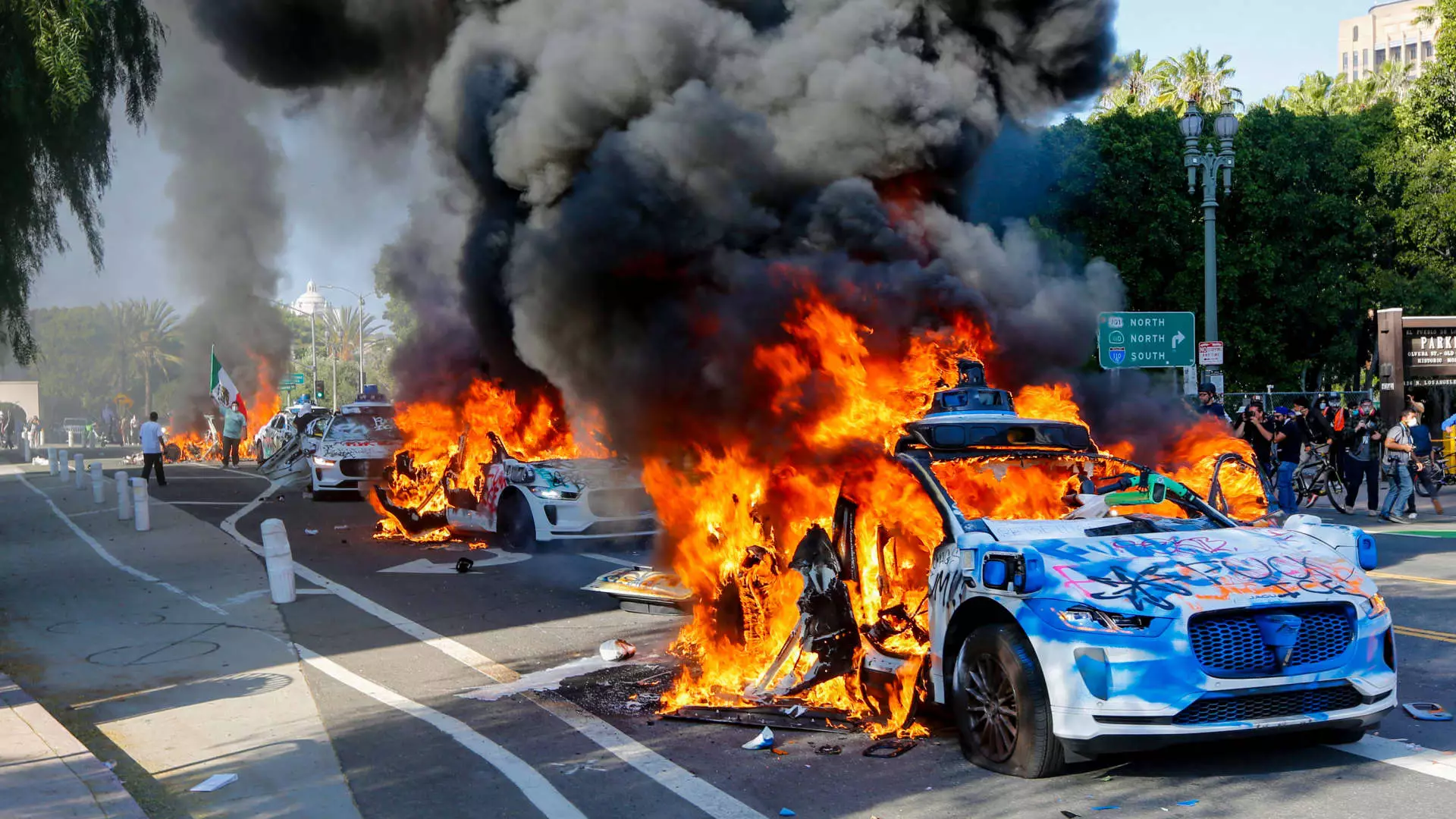In a stark demonstration of civil disobedience, downtown Los Angeles became the epicenter of anger and dissent against President Trump’s aggressive immigration policies. The tranquility of a city often known for its diverse and vibrant culture was shattered as protests erupted in response to recent actions taken by Immigration and Customs Enforcement (ICE). The image of Waymo’s autonomous vehicles engulfed in flames amidst the chaos symbolizes not just an attack on technology but a broader repudiation of a government that many feel is pursuing a damaging agenda.
On the surface, the protests appear to be about immigration, but delve deeper, and it becomes apparent that these demonstrations reflect widespread frustration toward a system that many believe has abandoned its foundational values of freedom and justice. In this atmosphere of urgency, the presence of the California National Guard only adds fuel to the fire, creating a sense of militarization that conflicts with the spirit of dialogue and reform that should characterize discussions about immigration.
Waymo’s Reluctant Role
As the flames of dissent danced around them, Waymo’s autonomous vehicles became an unintentional symbol of the technological future clashing with old-world fears and anxieties. The company, a subsidiary of Alphabet, faced vandalism of its vehicles that some might argue was undeserved. Yet, while it can be tempting to assert that these robotaxis were mere bystanders, we must acknowledge that their existence embodies a society increasingly reliant on automation, often at the expense of human jobs and dignity.
Waymo’s response to suspend services in the protest area indicates a cautious approach, one that seeks to prioritize safety amidst chaos. However, this decision raises critical questions about the vulnerability of technological solutions when placed in real-world contexts rife with tension. Are we, as a society, truly prepared to adapt to a world filled with autonomous vehicles when we cannot even navigate the volatility of our present social landscape?
The Dangers of Misplaced Anger
While the vandalism of Waymo vehicles can be interpreted as a direct protest against ICE’s policies, it raises ethical considerations regarding the methods employed to express dissent. Destruction and violence—however symbolic—can muddy the waters and detract from the important issues being advocated for. In an age of social media where visuals and narratives spread rapidly, an image of burning cars may overshadow the very real discussions surrounding human rights, immigration reform, and social justice.
Moreover, the environmental implications of setting these vehicles ablaze cannot be overlooked. The toxic byproducts released from burning lithium-ion batteries pose significant risks to not only protesters but also to emergency responders and innocent bystanders. This self-destructive method of protest may unwittingly undermine the very cause the demonstrators wish to uplift. A united front against injustices can be powerful, but it needs to wield its power responsibly.
Political Tensions and Their Fallout
The political climate in California demonstrates just how polarized the discourse has become. Governor Gavin Newsom’s intention to file a lawsuit against the Trump administration for what he describes as an illegal act of federalizing the National Guard illustrates how far-reaching and deeply entrenched this conflict has become. When politicians engage in threats of arrest and counter-arrests, it diverts the attention from the very real suffering faced by individuals affected by immigration raids.
Trump’s reaction in support of pursuing punitive action against local leaders only furthers the narrative of division. When political agendas seem to prioritize power struggles over community welfare, the resultant chaos can manifest in protests that, while rooted in legitimacy, can spiral into something unrecognizable. The burning of Waymo vehicles stands as a staggering symbol of this ongoing battle, illustrating the consequences of a fractured civil atmosphere.
The Future of Social Movements and Technology
As we reflect on the tensions between technology and social movements, one cannot help but consider the implications for our future. Will automation, like Waymo’s autonomous vehicles, coexist harmoniously with the evolving societal demands for equity and justice? The road ahead is uncertain, particularly when entwined with the volatile interplay of politics and activism.
The growing complexities of these relations will demand that all parties—policymakers, corporations, and citizens—actively engage in meaningful dialogue rather than resorting to violence and destruction. There must be a concerted effort to find solutions that prioritize human dignity and rights while navigating the challenges posed by advancing technology. The actions taken today may very well define the societal landscape of tomorrow, for better or worse.


Leave a Reply